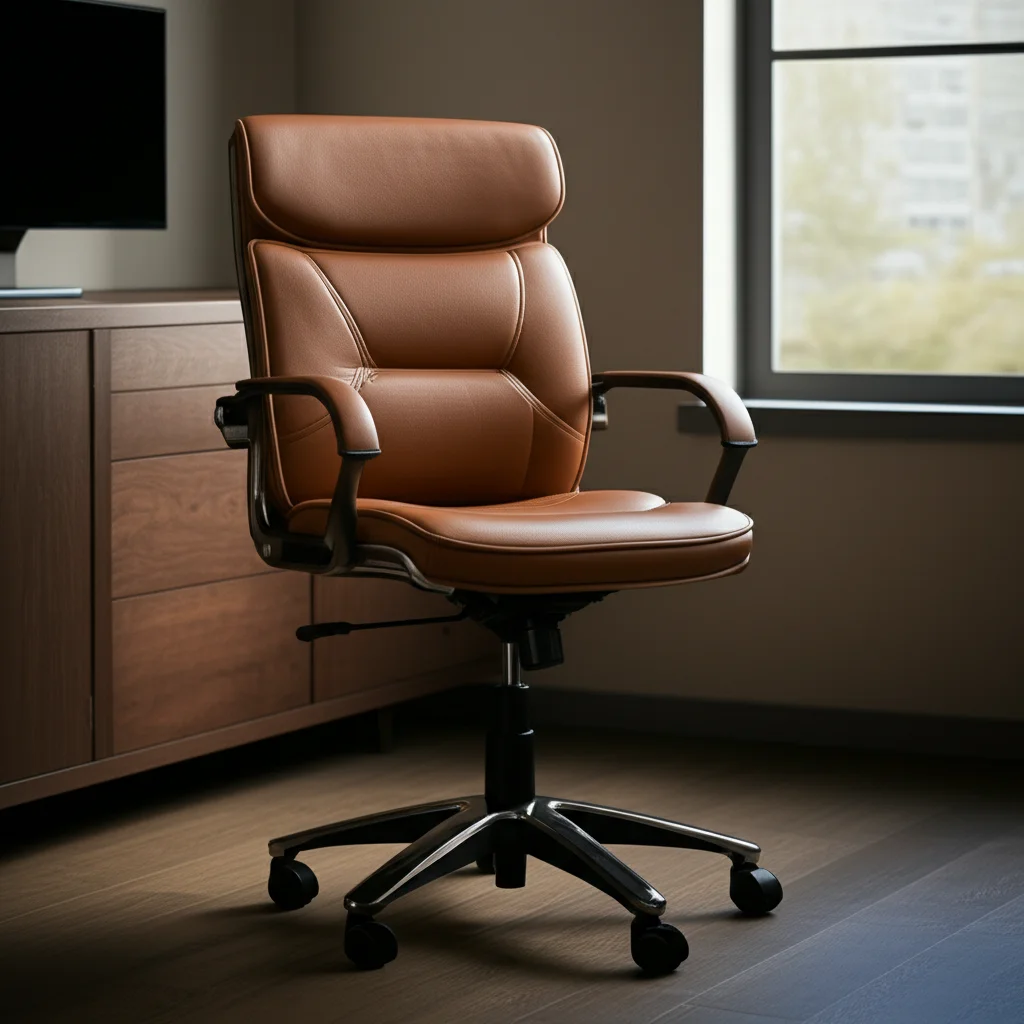· Todd Martin · Furniture Repair · 14 min read
How To Fix A Swivel Chair Base

How To Fix A Swivel Chair Base: Your Ultimate DIY Guide
A wobbly or sinking swivel chair can disrupt your focus and comfort. I know the frustration of leaning back only to feel a sudden dip, or trying to move across the room with a sticky wheel. This common household item often faces wear and tear, especially in its base. Fortunately, fixing a swivel chair base is often a straightforward task you can do yourself. This guide will walk you through diagnosing problems, gathering tools, and performing the necessary repairs to restore your chair’s stability and function. We will cover everything from simple tightening to replacing major components, ensuring your chair feels like new again.
Takeaway
- Identify the specific problem: wobbling, sinking, or broken base.
- Gather the correct tools and replacement parts.
- Disassemble your chair safely and systematically.
- Tighten loose components or replace faulty parts like the gas lift or base.
- Maintain your chair for long-lasting performance.
To fix a swivel chair base, first identify the specific issue: is it wobbly, sinking, or broken? Then, gather necessary tools and replacement parts such as a new gas lift or base. Carefully disassemble the chair, tighten any loose bolts, or replace the faulty component. Finally, reassemble the chair, ensuring all parts are secure for stable operation.
Understanding Common Swivel Chair Base Problems
My swivel chair started acting up recently, and I quickly realized the problem was with its base. Swivel chairs are essential for comfort and mobility in many settings, from offices to home studies. However, their complex design, especially the base, makes them prone to specific issues. Recognizing these common problems is the first step in learning how to fix a swivel chair base.
The base of a swivel chair supports your weight and allows movement. Over time, components can wear out or become loose. A common complaint is a wobbling chair. This usually indicates loose connections or worn parts within the base structure itself. Another frequent issue is a chair that sinks or loses its height adjustment. This points directly to a problem with the gas lift cylinder.
Sometimes, the chair might not swivel smoothly or it makes grinding noises. This often signals issues with the ball bearings or the central pivot mechanism. Finally, severe cracks or breaks in the base legs are clear signs of structural failure. Each of these problems requires a different approach to repair. Understanding the root cause ensures you apply the correct solution. It helps avoid unnecessary repairs and saves you time.
Essential Tools and Materials for Swivel Chair Repair
Before I start any DIY project, I make sure I have all the necessary tools. Fixing a swivel chair base is no different. Having the right tools and materials ready simplifies the repair process and prevents interruptions. Most of these items are common household tools or easily found at a hardware store.
You will typically need a set of wrenches or an adjustable wrench. These help tighten or loosen bolts on the chair base. A Phillips head screwdriver and a flathead screwdriver are also crucial for various fasteners. A rubber mallet can be very useful for gently tapping components apart or into place without causing damage. For safety, a pair of work gloves is a good idea to protect your hands from grease and sharp edges.
Beyond basic tools, consider specific materials for the repair. If your chair is sinking, a replacement gas lift cylinder will be necessary. If the base itself is cracked or broken, you will need a new swivel chair base. For noisy swiveling, a can of silicone lubricant or white lithium grease can work wonders. Sometimes, new casters (wheels) are needed if the old ones are damaged or don’t roll smoothly. Always ensure any replacement parts are compatible with your specific chair model for a perfect fit.
Diagnosing Your Swivel Chair’s Stability Issues
When my swivel chair started feeling unstable, I knew I needed to properly diagnose the issue before attempting a fix. A thorough diagnosis helps pinpoint the exact problem with your swivel chair base. This step prevents wasted effort and ensures you address the actual cause of the chair’s instability. Look for distinct symptoms to guide your repair efforts.
Start by observing the chair’s movement and feel. If the chair leans noticeably to one side, inspect the base legs and the central column for any visible damage or bending. A consistent sinking motion, where the chair slowly lowers itself even after you adjust the height, indicates a failing gas lift cylinder. If the chair simply wobbles back and forth or side to side, even when you are not moving, check the bolts connecting the base to the chair’s seat mechanism. These often loosen over time with regular use.
Listen for unusual sounds. Squeaks or groans when you swivel often mean the internal bearings need lubrication. If you hear cracking sounds, especially when applying weight, inspect the plastic or metal of the base for hairline fractures. Sometimes, the chair wheels (casters) can also contribute to instability if they are jammed or broken. By carefully examining each part of the swivel chair base and its function, you can accurately determine the component that requires attention. This focused approach makes the repair much more effective.
Step-by-Step Guide to Disassembling Your Swivel Chair
To effectively fix a swivel chair base, you often need to take the chair apart. Disassembly might seem intimidating, but it is a straightforward process if you follow the right steps. I always make sure I have a clear workspace and keep track of all the small parts. This ensures easy reassembly later.
First, you need to separate the seat from the gas lift and base. Most office chairs have a lever under the seat that controls the tilt mechanism. Locate the bolts attaching the seat to the mechanism plate. Use a wrench or screwdriver to loosen and remove these bolts. Carefully lift the seat assembly away. Place the bolts in a small container so they don’t get lost.
Next, you will need to separate the gas lift from the base and the seat mechanism. The gas lift cylinder typically fits snugly into a tapered hole in both the seat mechanism and the chair base. To remove the gas lift from the seat mechanism, turn the mechanism upside down. You might need to use a rubber mallet to tap the top of the gas lift cylinder gently until it comes loose. For stubborn cylinders, specialized tools can help. If you are struggling with a particularly tight cylinder, consider checking resources on how to replace swivel chair seat post bushing, as related components might also need attention.
Finally, separate the gas lift from the chair base. Turn the base upside down. The gas lift is usually friction-fitted into the center hole of the base. Again, a rubber mallet can be used to tap the gas lift from the bottom of the base. Apply firm, even taps around the cylinder’s edge where it meets the base. Be patient; some can be quite tight due to prolonged pressure. Once separated, you will have the base, the gas lift, and the seat mechanism as individual components, ready for repair or replacement.
Fixing a Wobbly Swivel Chair Base
A wobbly swivel chair base is one of the most common and annoying problems. It can make you feel unstable and uncomfortable while working. Fortunately, this issue often has a simple solution. I’ve successfully tightened many chairs that felt like they were about to collapse.
The first place to check for wobbling is the connection points. Many swivel chair bases are made of multiple pieces that bolt together. Over time, these bolts can loosen due to constant movement and weight shifts. Turn the chair upside down or tip it onto its side to access the underside of the base. Look for any visible bolts or screws connecting the five-star legs to the central hub or the casters to the legs. Use a wrench or a screwdriver to tighten any loose fasteners you find. Do not overtighten, as this can strip the threads or crack plastic components. Just make them snug.
If tightening bolts does not resolve the wobble, inspect the casters (wheels). Loose or damaged casters can also contribute to instability. Ensure each caster is securely inserted into its leg socket. If a caster appears broken or bent, replacing it might be necessary. Sometimes, the problem lies within the central swiveling mechanism itself. If the chair still wobbles after checking all external connections, the internal components, such as ball bearings, might be worn out. For more in-depth information on fixing internal swivel components, you might want to learn how to replace ball bearings in a swivel chair. This will help ensure all parts of your chair’s base provide solid support.
Replacing a Faulty Gas Lift Cylinder
A chair that slowly sinks or refuses to stay at your desired height has a failing gas lift cylinder. This component is crucial for height adjustment and shock absorption. Replacing it is a common fix and not as hard as it seems. I replaced one in my home office chair just last month, and the difference was immediate.
First, you need to remove the old, faulty gas lift. This involves separating the seat mechanism from the top of the cylinder and the chair base from the bottom. As mentioned in the disassembly section, use a rubber mallet to gently tap the seat mechanism off the top of the cylinder. Then, flip the base upside down and tap the cylinder out from the bottom. This can sometimes be tricky if the cylinder is stuck, but persistent, firm taps usually free it. Make sure to brace the base securely so it does not move while you are tapping.
Once the old cylinder is removed, prepare the new gas lift. Ensure it is the correct size and type for your chair. Most office chairs use standard gas lift sizes, but it is always good to double-check. Place the narrow top end of the new gas lift into the center hole of the seat mechanism. You might need to apply a small amount of downward pressure to seat it properly. Then, insert the wider, bottom end of the gas lift into the center hole of the chair base. The tapered design of the components will create a secure, friction-fit connection as you put weight on the chair. Sit on the chair and apply your weight, which helps fully seat the gas lift into both the base and the seat mechanism. This action creates a tight seal and ensures the new gas lift functions correctly, restoring your chair’s height adjustment.
Replacing the Entire Swivel Chair Base
Sometimes, the damage to your swivel chair base is too severe for simple repairs. If the legs are cracked, bent, or the central hub is broken, a full base replacement is necessary. This step will bring your chair back to full functionality and safety. I’ve had to do this when a leg on my old chair snapped, and it was a surprisingly easy swap.
Before you begin, purchase a new swivel chair base. Make sure it has the same five-star configuration as your old one and that the central hole is compatible with your chair’s gas lift cylinder. Bases come in different materials like plastic, nylon, or metal. If you are replacing a plastic base, consider upgrading to a metal one for increased durability. You might find some useful tips on material strength from articles like how to fix a metal chair leg if your new base is metal.
To replace the base, you first need to remove the existing gas lift cylinder from the old base. As described earlier, flip the base upside down and use a rubber mallet to tap the gas lift out of the central hole. This can sometimes require significant force if the gas lift is firmly seated. Once the gas lift is free, set the old, damaged base aside.
Now, take your new swivel chair base. Insert the bottom of your existing gas lift cylinder (or a new one, if you are replacing both) into the central hole of the new base. Push down firmly to seat it. The tapered design will secure it in place. Finally, reattach the seat assembly to the top of the gas lift cylinder. Place the seat mechanism squarely onto the top of the gas lift. Sit on the chair and apply your full weight. This action helps to fully secure the gas lift into both the new base and the seat mechanism, creating a stable and functional chair.
Maintaining Your Swivel Chair Base for Longevity
Fixing a swivel chair base is a great skill, but prevention is even better. Regular maintenance can significantly extend the life of your swivel chair and prevent future problems. I make it a point to perform simple checks on my chairs every few months. This keeps them in top shape and avoids unexpected issues.
Begin with routine cleaning, especially around the base and casters. Dust, hair, and debris can accumulate in the caster wheels, making them difficult to roll. You can use a pair of scissors or tweezers to remove tangled hair or strings from the wheel axles. For more thorough cleaning, you might find specific guidance in resources about how to clean chair wheels. Keeping the wheels clean ensures smooth movement and reduces strain on the base.
Periodically check all bolts and screws on the chair base. Over time, vibration and constant use can cause fasteners to loosen. Use the appropriate wrench or screwdriver to gently tighten any loose connections. This simple step can prevent wobbling and structural instability. It only takes a few minutes but makes a big difference.
Finally, consider lubrication for the swiveling mechanism. If your chair starts to squeak or feel stiff when swiveling, apply a small amount of silicone spray or white lithium grease to the central pivot point and any visible ball bearings. Avoid using oil-based lubricants as they can attract more dirt. Regular lubrication ensures the chair swivels smoothly and silently, preserving the integrity of its moving parts. These proactive maintenance steps will help your swivel chair base remain stable and functional for many years.
FAQ Section
Why is my swivel chair suddenly wobbly?
A wobbly swivel chair often indicates loose bolts connecting the chair’s components. Check the screws and bolts under the seat and where the legs meet the central hub. Tighten any loose fasteners with a wrench or screwdriver. Worn casters can also cause instability; inspect them for damage.
Can I replace just the gas cylinder in my swivel chair?
Yes, you can absolutely replace only the gas lift cylinder. This is a common repair for chairs that sink or fail to hold height. You will need to detach the old cylinder from the chair seat mechanism and the base, then insert a new, compatible one.
How do I know if my chair base is broken beyond repair?
If the chair’s star base has visible cracks, bends, or a snapped leg, it is likely beyond repair. These structural damages compromise safety and stability. In such cases, replacing the entire swivel chair base is the safest and most effective solution.
What tools do I need for basic swivel chair base repair?
For basic swivel chair base repairs, you will typically need a set of wrenches or an adjustable wrench, Phillips and flathead screwdrivers, and possibly a rubber mallet. Work gloves are also recommended for safety and cleanliness.
How do I stop my swivel chair from making noise?
If your swivel chair squeaks or grinds, the problem is often friction in the swivel mechanism or casters. Apply a silicone-based lubricant to the central pivot point and around the caster axles. Also, check for and remove any tangled hair or debris from the wheels.
Conclusion
A well-maintained swivel chair significantly enhances comfort and productivity. You now have the knowledge to fix a swivel chair base, addressing common issues from wobbles to complete component failures. We covered diagnosing the problem, gathering the right tools, and executing step-by-step repairs like tightening connections or replacing a faulty gas lift or the entire base. Remember, a little preventive maintenance goes a long way in extending your chair’s lifespan.
Don’t let a faulty swivel chair base diminish your comfort or productivity. Take action using the steps outlined in this guide. You can restore your chair to optimal condition. A functional chair provides better support and makes your workspace more enjoyable. If you found this guide helpful, share it with others facing similar chair issues!
- swivel chair repair
- office chair fix
- chair base issues
- DIY furniture
- gas lift replacement
- wobbly chair
- home office setup





